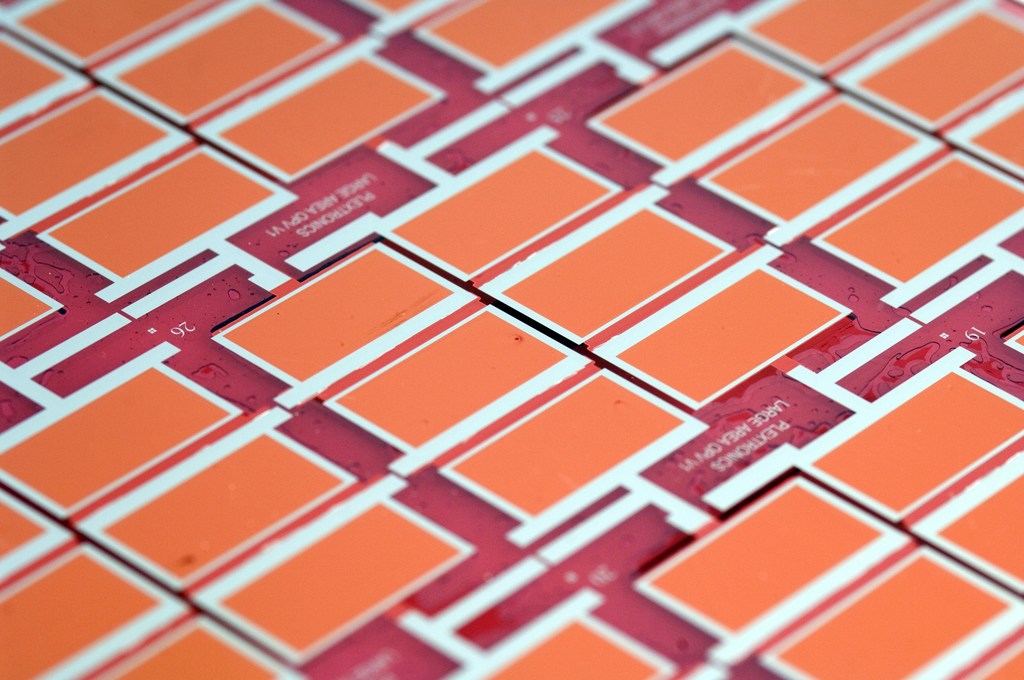Researchers said they notched an 18.07% power conversion efficiency from a plastic solar cell, also known as an organic photovoltaic (OPV) cell.
The team achieved what they said was a record conversion efficiency with a design strategy that improves the cell’s open-circuit voltage, short-circuit voltage, and fill factor.
Improving all three metrics—which represent how efficiently a solar cell converts sunlight into electricity—is difficult to do, they said. This is because of constraints related to using two components to create the binary donor-acceptor blend in an OPV cell’s light-absorbing layer. Changing a single component to improve one metric can negatively affect another, leading to performance trade-offs.
Researchers from the National Renewable Energy Laboratory, Shanghai Jiao Tong University, and the University of Massachusetts Amherst showed that using four components in an OPV device’s active layer could better balance the microstructure and electronic function of the cell’s absorber layer. The strategy was described in a Nature Communications article.
OPV materials are semiconductors made up of common organic elements like carbon, hydrogen, nitrogen, fluorine, oxygen, and sulfur. They are man-made molecules and polymers that can be synthesized in a chemistry lab. Their raw materials are typically cheap and abundant; the manufacturing processes for creating them have been used in industries that make household items like plastic wrap and Tupperware.
The research team said that OPV blends are handled in liquid form and sprayed or coated onto rigid or flexible surfaces. The number of potential applications is broad, yet OPV’s have only been intensively researched since the early 2000s, after a relatively new molecule called a fullerene (its discovery led to a Nobel Prize in Chemistry in 1996) was incorporated as the acceptor component in OPV cells. A second Nobel Prize in 2000 recognized the discovery and development of conductive polymers.
Enevate raises funds for its EV battery
Battery maker Enevate said it secured $81 million in Series E funding led by Fidelity Management & Research Co. The funding is intended to provide the company with new resources aimed at accelerating global adoption of the company’s silicon anode-based lithium-ion batteries for electric vehicles. Existing investors Mission Ventures and Infinite Potential Technologies also participated in the round.
With this latest funding round, Enevate has raised $191 million to date.
The company said its technology is designed to provide EV owners with a five-minute charge. It holds a portfolio of 350 patents related to silicon Li-ion cell technology, including anode, cathode, electrolyte, separator, formation, cell design and cell architecture.
Venture targets Li-ion battery recycling
The Heritage Group and Heritage Environmental Services launched a new division, Heritage Battery Recycling (HBR) to focus on demand for lithium-ion battery recycling.
In collaboration with Romeo Power, HBR said it will develop a battery reuse and recycling facility in the southwestern United States. The collaboration opens a market opportunity that includes commercial truck manufacturers, commercial fleet managers, and other business owners. In late January, Romeo and Republic Services agreed to develop Romeo’s battery technology for use in Republic’s future fleet of electric garbage trucks.
Heritage also partnered with Heritage-Crystal Clean, a fleet services provider, that gives HBR access to customer locations, power units, and facility locations across North America.
Highview Power raises funds for long-duration storage
Highview Power closed its Growth Capital round of funding with more than $70 million, bringing its total amount of funding and grants to more than $145 million. The round includes a previously announced $46 million investment from Sumitomo Heavy Industries and additional investments from Janus Continental Group and TSK, along with a $5.5 million contribution from the original and founding investors.
This round of funding enables Highview Power to continue its global expansion and moves additional long-duration energy storage projects into the commercialization phase. Highview Power said it has a late-stage pipeline of more than 4 GWh of projects in the U.S., Europe, and Latin America. It also has 700 MWh of projects currently under development.
Highview Power’s energy storage facilities are based on its cryogenic energy storage technology, which the company said can offer multiple gigawatt-hours of storage. The company said that when paired with renewables, its facilities are equivalent in performance to thermal and nuclear baseload power.
This content is protected by copyright and may not be reused. If you want to cooperate with us and would like to reuse some of our content, please contact: editors@pv-magazine.com.









“OPV materials are semiconductors made up of common organic elements like CARBON, hydrogen, nitrogen, fluorine, oxygen, and sulfur. They are man-made molecules and polymers that can be synthesized in a chemistry lab.” $100 million prize for the best way to capture CARBON from Elon Musk. Here is one way and how about Carbon-based batteries even if it is in the casing. Graphite is a form of Carbon and could be used in conductors used to heat batteries in cold climates.